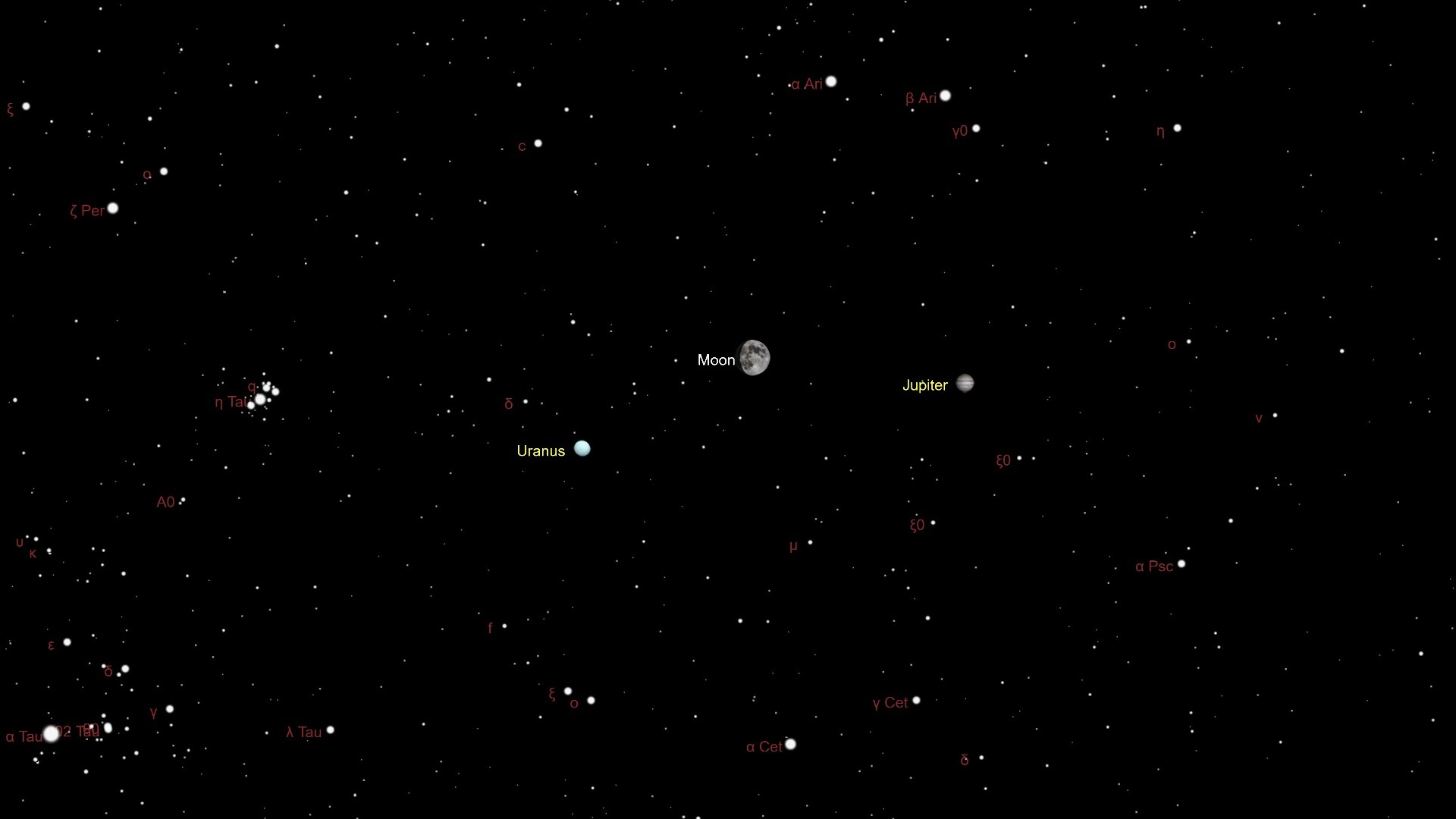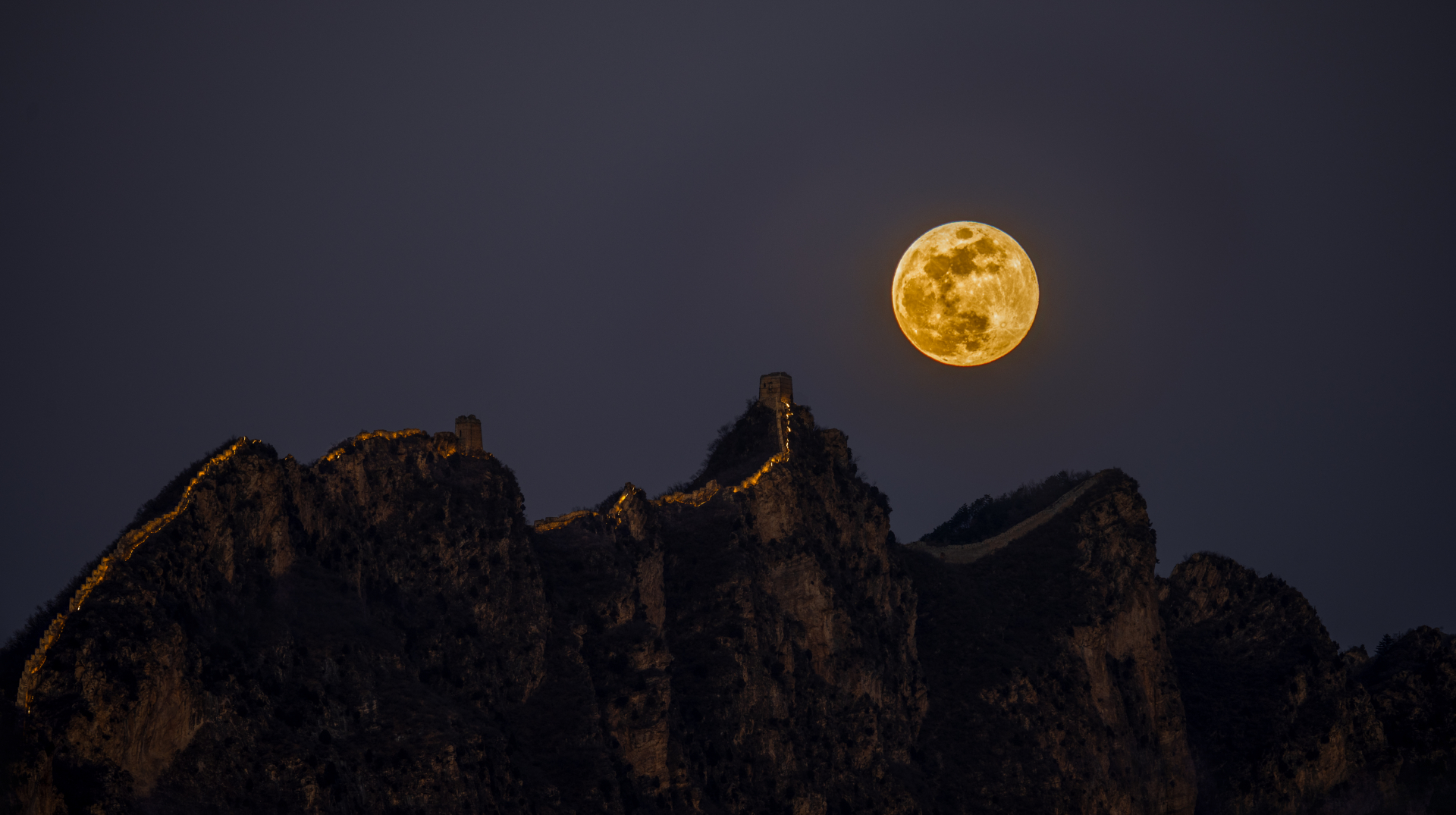See the moon and Jupiter enjoy their final meet-up of 2023 in the night sky tonight
The 10-day-old moon and Jupiter will be in the constellation of Aries, the Ram, during the meet-up.

The moon will meet up with Jupiter, the solar system's largest planet, for the last time in 2023 on Friday (Dec. 22) when the two celestial bodies make a close approach in the sky. Around the same time, the two celestial bodies will share the same right ascension, an arrangement astronomers call a conjunction.
The 10-day-old moon will be 86% illuminated during the close approach, with the lit lunar face currently growing as the moon heads to 2023's final full moon, December's Cold Moon, on Tuesday, Dec. 26.
From New York City, the pre-Christmas meeting between the moon and Jupiter will be visible soon after the two celestial bodies rise over the horizon at around 1:18 p.m. EST (1818 GMT), according to In the Sky. The 10-day-old moon will pass just 2 degrees to the north of Jupiter, with both celestial objects located in the constellation of Aries, the Ram, during the meet-up.
The close approach and conjunction of the moon and the solar system's largest planet will be visible until just before they start to set at around 2:50 a.m. EST (0750 GMT). That means that skywatchers will have a few hours to spot this conjunction after the sun sets and the skies darken at 4:31 p.m. EST (2131 GMT). Despite this being a close approach, the moon and Jupiter will still be too widely separated to be seen together in the narrow field of view of a telescope but should be visible together in the wide field of view of binoculars.
Related: Night sky, December 2023: What you can see tonight

Looking for a telescope for the next night sky event? We recommend the Celestron Astro Fi 102 as the top pick in our best beginner's telescope guide.
During the conjunction, the moon will have a magnitude of -12.5, while Jupiter will be dimmer with a magnitude of -2.7, with the minus prefix indicating a particularly bright object in the sky over Earth.
During the close approach, the moon will dominate Jupiter in the sky in terms of size, but this is merely an effect of our perspective from Earth, of course. The moon is much closer to our planet, which is the third planet from the sun, than Jupiter, which is the fifth planet in the solar system, but the latter vastly overwhelms the other in terms of size.
Breaking space news, the latest updates on rocket launches, skywatching events and more!
Jupiter has a width of around 89,000 miles (143,000 km) and is thus 11 times the size of Earth, and our planet is around four times as large as the moon, which has a diameter of around 2,200 miles (3,500 kilometers). That means it would take at least 44 moons to stretch across the diameter of Jupiter.
In fact, the gas giant is so vast that it has moons that are larger than the Earth's moon and even some solar system planets. The largest Jovian moon is Ganymede which is also the solar system's largest moon.
With a diameter of 3,270 miles (5,268 km), Ganymede is bigger than dwarf planet Pluto and is even wider than the planet Mercury, which has a diameter of 3,032 miles (4,879 km). Jupiter's moon, Titan, is also larger than Mercury, but this is a result of the fact its atmosphere is swelled out.
Jupiter is currently around 403 million miles (650 million kilometers) from Earth, which is around 4.32 times the distance between Earth and the sun, and means that light would take around 35 minutes to travel from our planet, past Mars, and to Jupiter.
The moon, on the other hand, is 238,855 miles (384,400 kilometers) away from Earth, while the gas giant is an average of 444 million miles (715 million km) away from our planet. That means the Earth-moon system would fit within the current distance to Jupiter around 1687 times over.
When the gas giant is at its closest to the Earth, it is still 365 million miles (588 million km) away, while at its furthest, Jupiter is 601 million miles (967 million km) away. That means the distance to Jupiter varies by 236 million miles, a change in distance alone that is large enough to fit the Earth-moon system within it around 988 times!
Though this is the final meet-up of the moon and Jupiter this year, it won't be long before the two celestial bodies meet again. The moon will next make a close approach to Jupiter on Thursday, Jan. 18, just a week after the first new moon of 2024 and the start of next year's first complete lunar cycle.
If you are hoping to catch a look at the next conjunction between the moon and Jupiter, our guides to the best telescopes and best binoculars are a great place to start.
If you're looking to snap photos of these celestial objects or the night sky in general, check out our guide on how to photograph the moon, how to photograph planets, as well as our best cameras for astrophotography and best lenses for astrophotography.
Editor’s Note: If you snap an image of the moon with Jupiter and would like to share it with Space.com’s readers, send your photo(s), comments, and your name and location to spacephotos@space.com.

Robert Lea is a science journalist in the U.K. whose articles have been published in Physics World, New Scientist, Astronomy Magazine, All About Space, Newsweek and ZME Science. He also writes about science communication for Elsevier and the European Journal of Physics. Rob holds a bachelor of science degree in physics and astronomy from the U.K.’s Open University. Follow him on Twitter @sciencef1rst.
